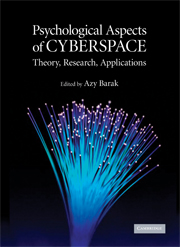Book contents
- Frontmatter
- Contents
- List of Tables
- List of Figures
- Preface
- List of Contributors
- 1 Reflections on the Psychology and Social Science of Cyberspace
- 2 Privacy, Trust, and Disclosure Online
- 3 Internet Abuse: Emerging Trends and Lingering Questions
- 4 Flow Experience in Cyberspace: Current Studies and Perspectives
- 5 Cybertherapeutic Theory and Techniques
- 6 Exposure in Cyberspace as Means of Enhancing Psychological Assessment
- 7 Down the Rabbit Hole: The Role of Place in the Initiation and Development of Online Relationships
- 8 The Sexy Side of the Internet: An Examination of Sexual Activities and Materials in Cyberspace
- 9 The Contact Hypothesis Reconsidered: Interacting via Internet: Theoretical and Practical Aspects
- 10 Influences on the Nature and Functioning of Online Groups
- 11 Online Motivational Factors: Incentives for Participation and Contribution in Wikipedia
- 12 How Internet-Mediated Research Changes Science
- Index
- References
11 - Online Motivational Factors: Incentives for Participation and Contribution in Wikipedia
Published online by Cambridge University Press: 05 June 2012
- Frontmatter
- Contents
- List of Tables
- List of Figures
- Preface
- List of Contributors
- 1 Reflections on the Psychology and Social Science of Cyberspace
- 2 Privacy, Trust, and Disclosure Online
- 3 Internet Abuse: Emerging Trends and Lingering Questions
- 4 Flow Experience in Cyberspace: Current Studies and Perspectives
- 5 Cybertherapeutic Theory and Techniques
- 6 Exposure in Cyberspace as Means of Enhancing Psychological Assessment
- 7 Down the Rabbit Hole: The Role of Place in the Initiation and Development of Online Relationships
- 8 The Sexy Side of the Internet: An Examination of Sexual Activities and Materials in Cyberspace
- 9 The Contact Hypothesis Reconsidered: Interacting via Internet: Theoretical and Practical Aspects
- 10 Influences on the Nature and Functioning of Online Groups
- 11 Online Motivational Factors: Incentives for Participation and Contribution in Wikipedia
- 12 How Internet-Mediated Research Changes Science
- Index
- References
Summary
Cyberspace has introduced new and intriguing means for knowledge sharing as well as new structures of mediated knowledge-building communities. Considering the various forms of online communities, it should be difficult to overstate the significance of Wikipedia as a landmark in building communal knowledge repositories.
Wikipedia is an online collaboratively written encyclopedia. It has unique aspects of users' involvement in the production of content and its function as a community. In less than five years of existence, Wikipedia has acquired both avid advocates and ardent adversaries. Although there have been some public and academic debates about the quality of its content, as the rapid growth of its articles and numbers of active users (Wikipedians) continues, most people agree that at least the English version of Wikipedia is approaching critical mass where substantial content disasters should become rare. Wikipedia's existence and success rely on users' inputs. Our chapter focuses on Wikipedians' incentives for contributing to Wikipedia. The popular observation is that Wikipedia only works in practice. In theory, it can never work. How does Wikipedia mobilize the levels of participation that make it “work in practice”?
Wikipedia's growth, from the time of its foundation in 2001, has been impressive in all conceivable dimensions. Expansion metrics have accelerated in terms of volume, numbers of articles, visitors, and percentage of contributors. There are, by the time of this writing, 250 language editions of Wikipedia. The English-language version is the largest. It contains more than two million articles.
- Type
- Chapter
- Information
- Psychological Aspects of CyberspaceTheory, Research, Applications, pp. 243 - 267Publisher: Cambridge University PressPrint publication year: 2008
References
- 65
- Cited by



